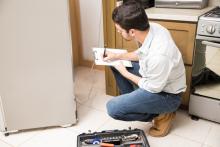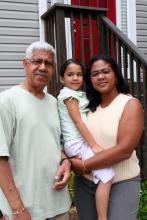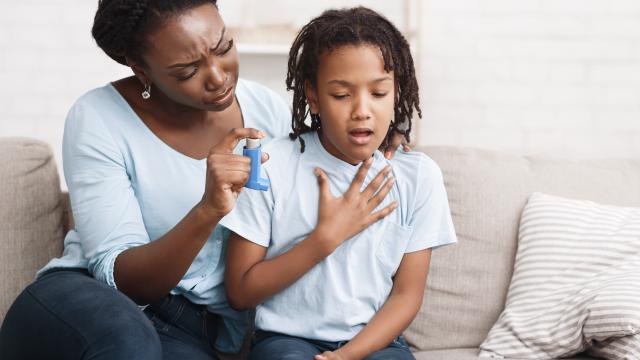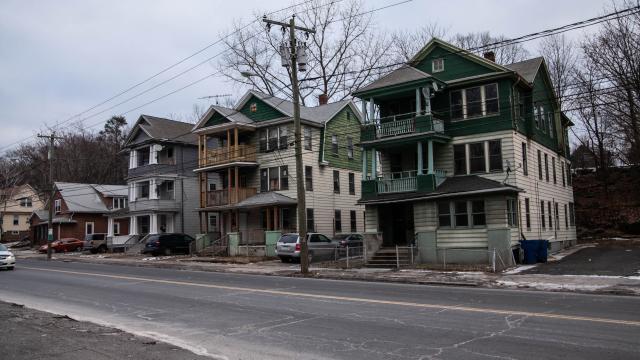Asthma-Safe Homes Program
Delivering free in-home asthma services to help families breathe easier
Create your asthma-safe home
The Asthma-Safe Homes Program provides free, in-home asthma education and home repair services to eligible families with poorly controlled asthma. Our goal is to help kids and expecting parents with asthma live their best lives by building asthma self-care skills and reducing home asthma triggers, such as tobacco smoke, mold, dust mites, household chemicals, pests, and moisture from poor ventilation or leaking roofs, windows and plumbing.
Children ages 2–18 years and pregnant parents with asthma who are eligible for Medicaid state health insurance can access program services through a referral process. The Asthma-Safe Homes Program currently serves clients in Milwaukee, Kenosha, Racine, Rock, and Brown counties. Learn more about how we can help you create an asthma-safe home.
The Asthma-Safe Homes Program was created in 2021 with federal approval under the Children’s Health Insurance Program (CHIP). It builds upon the success of the Asthma Care Program, which provided asthma education to kids struggling to control their asthma symptoms.
The Asthma Care Program made a big difference in helping clients improve their asthma management and quality of life. Seventy-nine percent of clients enrolled in the program reduced their asthma-related emergency room visits and 50 percent of clients avoided hospital stays, according to data from the Wisconsin Department of Health Services, P-02403 (PDF)
The Asthma-Safe Homes Program provides two main services:
Component One: in-home asthma education and asthma products. An asthma educator provides asthma self-management education to clients during two to six home visits. Topics include:
- Asthma self-management education on asthma symptoms, triggers, medication use, and asthma action plans.
- Home walkthrough to identify asthma triggers and ways to address them.
- Referral for limited home repairs if major asthma triggers are identified. (See component two of the Asthma-Safe Homes Program below.)
- Up to $1,000 worth of free asthma-friendly products that can help reduce asthma triggers in the home. Products may include dust mite covers for pillows and mattresses, asthma-friendly cleaning kits, vacuums with HEPA filters, home air cleaners, air conditioners, and more.
For more information about asthma self-management, see Asthma Care: Your Guide to Managing Asthma, P-02168 (PDF)
Component Two: environmental home repair services. A trained asthma home assessor will conduct an in-depth review of your home and recommend repairs worth up to $5,000. Steps in the home repair process include:
- Getting a referral from the asthma educator to access eligible home repair services.
- Scheduling a time for a trained home assessor to investigate sources of asthma triggers and recommend ways to reduce them, such as mold cleanup, carpet removal, pest control, leaking plumbing or roof repairs, and drafty window and door sealing.
- Getting approval from property owners for recommended repairs and cleanup before home repairs begin. The Asthma-Safe Homes Program and partners can help get property owner approvals.
- Scheduling free home repair work with certified contractors worth up to $5,000 per home.
For more information about ways to reduce home asthma triggers and other health hazards, visit Healthy Homes: Keep your Homes Safe and Healthy.
The Asthma-Safe Homes Program can help you:
- Identify and fix asthma triggers in your home.
- Learn how to better control your asthma or a family member’s asthma.
- Live your best life.
- $ave money by:
- Using less medication.
- Making fewer trips to the emergency room or urgent care clinic.
- Avoiding overnight stays in the hospital.
- Missing fewer days of school and work.
- Covering costs for home assessment and repair services for eligible clients.
- Accessing free products to reduce home asthma triggers.
- Accessing free professional services to create a healthier home.
The local partners who are providing Asthma-Safe Homes Program services in Milwaukee, Kenosha, Racine, Rock, and Brown counties can be found on our Service Providers webpage.
More than 500,000 children and adults have asthma in Wisconsin. About 8.4 percent of all children statewide have asthma, and it remains the most common chronic disease in children.
Racial, social, and economic factors impact asthma burden in Wisconsin. Black, Native American, and low-income people in Wisconsin have higher rates of asthma than other Wisconsinites. Families of color and low-income families are more likely to have worse asthma outcomes due to poor housing quality, and exposure to higher levels of pollution and other asthma triggers.
In addition to improving asthma outcomes, the Asthma-Safe Homes Program aims to improve asthma disparities among children and pregnant parents who are eligible for Medicaid state health insurance. Improving access to asthma education, health care based on the latest asthma management guidelines, and healthy living environments will help reduce asthma disparities.
Select a track below to find out how the Asthma-Safe Homes Program works for you
Families with Asthma
If you or your child has asthma, learn how to participate in the Asthma-Safe Homes Program.
Health Care Providers
Learn the benefits of the Asthma-Safe Homes Program and find resources on clinical asthma management.
Property Owners
Learn about the many benefits to property owners and their tenants of participating in the Asthma-Safe Homes Program.
In the news
March 27, 2025, Children's Wisconsin: Winning the fight against asthma
January 7, 2025, TMJ4: Grandmother finds relief for granddaughter's asthma through revitalization program
Questions?
Email the Asthma-Safe Homes Program at DHSAsthmaSafeHomes@dhs.wisconsin.gov or call 608-266-1112.







